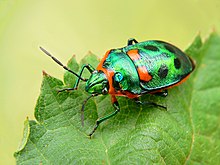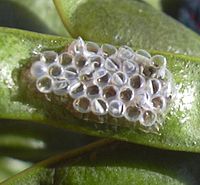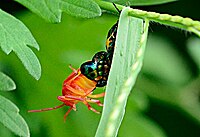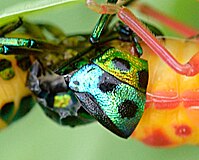Scutelleridae
| Jewel bugs | |
|---|---|

| |
Scutiphora pedicellata, a jewel bug from Australia
| |
| Scientific classification | |
| Domain: | Eukaryota |
| Kingdom: | Animalia |
| Phylum: | Arthropoda |
| Class: | Insecta |
| Order: | Hemiptera |
| Suborder: | Heteroptera |
| Infraorder: | Pentatomomorpha |
| Superfamily: | Pentatomoidea |
| Family: | Scutelleridae Leach, 1815 |
| Subfamilies | |
| |
Scutelleridae is a
Description
Jewel bugs are small to medium-sized oval-shaped bugs with a body length averaging at 5 to 20 mm (0.20 to 0.79 in).[3] They can easily be distinguished from stink bugs (Pentatomidae) because the shield-like enlarged last section of their thorax (known as the scutellum, Latin for "little shield") completely covers the abdomen and the wings.[4]
Despite their resemblance to beetles, jewel bugs are
The heads of jewel bugs are triangular and the antennae have three to five segments.[8] Like all heteropterans, jewel bugs are characterized by a segmented beak-like mouthpart (known as the rostrum).[2] During feeding, jewel bugs inject proteolytic enzymes in their saliva into plants, digesting plant matter into a liquid form which they then suck up.[9] The tarsus has three segments (tarsomeres).[6]
- at Mumbai
-
Shield-backed bug (Graptocoris aulicus) nymph, Uganda
-
Chrysocoris sp., an iridescent green jewel bug from India.
-
A brilliant orange, red, and black giant jewel stink bug Eucorysses grandis, from Japan. The pattern and coloration of this species can often vary from pale cream to deep red.
Colours
Though some species are quite drab,[10] the most conspicuous jewel bugs are often brilliantly colored, exhibiting a wide range of iridescent metallic hues that change with the view angle.[6] The colors are the result of a combination of factors. Some species like Chrysocoris stockerus and Scutellera nobilis display colors from multiple thin layers of pigmented chitin. The colors often change or become duller when the specimens are dried, due to the topmost chitinous layer becoming opaque and obscuring the colors of the bottom layer. The colors can be restored by moistening the surfaces with water.[11]
Iridescence (or goniochromism) in jewel bugs like Poecilocoris lewisi are the result of structural coloration. Instead of pigments, the colors are caused by the interference, diffraction, or scattering of light by numerous tiny structures.[citation needed]
In Poecilocoris lewisi, multiple tiny conical protuberances around 900
In other species like the African shield bug (Calidea panaethiopica), the dorsal cuticle is dotted with tiny regularly spaced hemispherical cavities. The depressions act like Bragg mirrors. When light hits the pitted surface, it gives off multiple reflections resulting in the distinctive two tone yellow-blue iridescence.[12]
The colors and patterns on jewel bugs can vary significantly between instars and even within adults of a species.[13]
Jewel bugs are also known to
Ecology and life cycle
All jewel bugs feed on
Like all hemipterans, jewel bugs undergo incomplete metamorphosis (hemimetaboly) and do not possess larval and pupal stages. Instead the adults develop from several stages (instars) of nymphs (usually five) through successive moltings (ecdysis). Nymphs resemble the adults except for size and the absence of wings. They can be of different coloration or patterns from adults.[15]
Some species are known to exhibit parental care of eggs and nymphs. Notable examples of which are Cantao parentum,[18] Pachycoris klugii,[19] Pachycoris stalii,[20] Pachycoris torridus, and Tectocoris diophthalmus.[13][21]
-
A cluster of the empty barrel-shaped eggs of theKoa bug (Coleotichus blackburniae) from Hawaii. The 'lids' can clearly be seen.
-
A jewel bug molting (ecdysis). The pale-colored adult is emerging from its old exoskeleton, in the foreground are two nymphs.
-
A jewel bug from the Philippines feeding on Jatropha.
-
Calliphara excellens from Japan.
Reproduction
Females possess a
Male jewel bugs of the genus Hotea possess an unusually large, spiky, and heavily sclerotized genitalia. They are used in a mating practice known as traumatic insemination, a result of evolutionary sexual conflict. Male Hotea bugs tear through the female reproductive ducts to deposit sperm, inflicting substantial damage to the female in the process.[23]
Defenses
Like
Nymphs and adults often exhibit clustering behavior, being found in large numbers close to each other. This behavior is thought to have an evolutionary advantage. The more individuals present in an area, the stronger the odor of the chemicals released when the bugs are threatened.[18] If this fails, stink bugs will react to threat by flying away or dropping to the ground.[2]
Classification and evolution
Scutellerids were first described by the
In| ← |
| |||||||||||||||||||||||||||||||||||||||||||||||||||||||||||||||||||||
Subfamilies and genera
The family is composed of about 81
Elvisurinae
Auth.: Stål, 1872. Widespread distribution, with the type genus Elvisura found in southern Africa; only one species of Elvisurinae, Solenosthedium bilunatum, is found in Europe.[33]
- Austrotichus Gross, 1975 - monotypic A. rugosus Gross, 1975
- Coleotichus White, 1839
- Elvisura Spinola, 1837
- Solenosthedium Spinola, 1837
- Solenotichus Martin, 1897
Eurygastrinae
Auth.: Amyot & Audinet-Serville, 1843
- Tribe Eurygastrini Amyot & Audinet-Serville, 1843
- Eurygaster Laporte, 1833
- Polyphyma Jakovlev, 1877
- Tribe Psacastini Mulsant & Rey, 1865
- Ceratocranum Reuter, 1890
- Periphima Jakovlev, 1889
- Periphymopsis Schouteden, 1904
- Promecocoris Puton, 1886
- Psacasta Germar, 1839
- Xerobia Stål, 1873
Hoteinae
Auth.: Carapezza, 2008
- Deroplax Mayr, 1864
- Ellipsocoris Mayr, 1864
- Hotea Amyot & Serville, 1843
Odontoscelinae
Auth.: Amyot & Audinet-Serville, 1843; mostly European
- Holonotellus Horváth, 1895
- Irochrotus Amyot & Serville, 1843
- Odontoscelis Laporte, 1833
Odontotarsinae
Auth.: Mulsant & Rey, 1865
- Tribe Odontotarsini Mulsant & Rey, 1865
- Ahmadocoris Carapezza, 2009
- Alphocoris Germar, 1839
- Melanodema Jakovlev, 1880
- Odontotarsiellus Hoberlandt, 1955
- Odontotarsus Laporte, 1833
- Urothyreus Horváth, 1921
- Tribe Phimoderini Fuente, 1974
- Euptychodera Bergroth, 1908
- Fokkeria Schouteden, 1904
- Morbora Distant, 1899
- Phimodera Germar, 1839
- Vanduzeeina Schouteden, 1904
Pachycorinae
Auth.: Amyot & Audinet-Serville, 1843
- Acantholomidea Sailer, 1945
- Agonosoma Laporte, 1833
- Ascanius (bug) Stål, 1868
- Brailovskylus Eger, 2017
- Camirus Stål, 1862
- Chelycoris Bergroth, 1891
- Chelyschema Bergroth, 1891
- Coptochilus Amyot & Serville, 1843
- Crathis (bug) Stål, 1861
- Diolcus Mayr, 1864
- Dystus Stål, 1862
- Ephynes Stål, 1868
- Galeacius Distant, 1889
- Homaemus Dallas, 1851
- Lobothyreus Mayr, 1864
- Misippus Stål, 1868
- Nesogenes Horváth, 1921
- Orsilochides Kirkaldy, 1909
- Pachycoris Burmeister, 1835
- Polytes Stål, 1868
- Sphyrocoris Mayr, 1864
- Stethaulax Bergroth, 1891
- Symphylus Dallas, 1851
- Testrina Walker, 1867
- Tetyra Fabricius, 1803
- Tiridates (bug) Stål, 1868
Scutellerinae
Auth.: Leach, 1815. Selected genera:
- Augocoris
- Calliphara
- Cantao
- Chrysocoris
- Eucorysses Amyot & Audinet-Serville, 1843
- Lampromicra
- Scutellera Lamarck, 1801
- Sphaerocoris
- Tectocorinae McDonald & Cassis, 1984 (monotypic)
- TectocorisHahn, 1834
Economic significance
Though most jewel bugs do little harm to crop plants,
Eurygaster integriceps, in particular, is a very destructive pest of cereal crops in North Africa, the Balkans, and western and central Asia. Other scutellerids known under the name 'sunn pest' include members of the genus Odontotarsus, among others.[35] Methods of control for sunn pests have included biological pest control, using wasps of the family Scelionidae from the genera Trissolcus and Ooencyrtus.[citation needed]
The
Conservation
Biological methods of pest control have sometimes backfired. A
Gallery
-
Molting (moulting) jewel bug (1)
-
Molting (moulting) jewel bug (2)
-
Molting (moulting) jewel bug (3)
-
Molting (moulting) jewel bug (4)
See also
References
- ^ "Scutelleridae - Jewel Bugs". Commonwealth Scientific and Industrial Research Organisation (CSIRO) Entomology. Retrieved April 27, 2011.
- ^ ISBN 978-1-4020-6242-1.
- ISBN 978-1-4051-5142-9.
- ]
- ^ "Scutelleridae". National Center for Biotechnology Information (NCBI).
- ^ ISBN 978-0-8014-2066-5.
- ^ a b "Family Scutelleridae - Shield-backed Bugs". BugGuide. Retrieved April 27, 2011.
- ^ "Jewel bugs, Shield Backed Bugs -Family Scutelleridae". Brisbane Insects and Spiders Home Page. Retrieved April 27, 2011.
- ^ E. Grünbacher & B. Kromp (2008). "Investigations on the occurrence of wheat bugs (Scutelleridae, Pentatomidae; Heteroptera) in organic farming of Eastern Austria" (PDF). 1st Scientific Conference within the framework of the 8th European Summer Academy on Organic Farming. Retrieved April 27, 2011.
{{cite journal}}: Cite journal requires|journal=(help) - ^ Scott Fabricant, Mariella Herberstein & Darrell Kemp. "Mechanisms and Functions of Colour in the Hibiscus Harlequin Bug" (PDF). The Australasian Society for the Study of Animal Behaviour. Retrieved April 28, 2011.
{{cite journal}}: Cite journal requires|journal=(help) - ^ ISBN 978-981-270-783-3.
- PMID 19391778.)
{{cite journal}}: CS1 maint: multiple names: authors list (link - ^ . Retrieved April 27, 2011.
- ^ Hugh D.C. Heron (2009). "Polymorphism in four tortoise beetles from Queensburgh, South Africa (Chrysomelidae: Cassidinae)" (PDF). Genus. 22 (1). University of Wrocław: 133–149. Retrieved April 28, 2011.
- ^ ISBN 978-0-7614-7266-7.
- ^ hdl:1811/31918.
- ^ ISSN 0006-3088.
- ^ a b "Scutelleridae: Shield-backed Bugs". Save Our Waterways Now. Retrieved April 28, 2011.
- ISBN 978-0-674-02163-1.
- PMID 17119611.)
{{cite journal}}: CS1 maint: multiple names: authors list (link - ^ David A. Rider. "Pentatomoid Species Known to Exhibit Parental Care". Department of Entomology, North Dakota State University. Retrieved April 27, 2011.
- ISBN 978-0-412-03961-4.
- ISBN 978-0-691-12218-2.
- ISBN 978-3-540-21308-6.
- ^ "Scutelleridae". Integrated Taxonomic Information System.
- ^ "Scutelleridae Leach, 1815" at the Encyclopedia of Life
- ^ ISBN 978-0-643-06875-9.)
{{cite book}}: CS1 maint: multiple names: authors list (link - ^ S2CID 41951432. Retrieved April 27, 2011.
- ^ a b Dimitri Forero (March 13, 2009). "Pentatomoidea". Tree of Life Web Project. Retrieved April 28, 2011.
- ^ ISBN 978-1-4200-4185-9.
- ^ Biolib: family of shield-backed bugs, Scutelleridae Leach, 1815 (retrieved 10 February 2024)
- ^ David A. Rider. "Classification". Department of Entomology, North Dakota State University. Retrieved April 27, 2011.
- ^ Škorput, Jadranka; Martinović, Matea; van der Heyden, Torsten; Skejo, Josip (March 2020). "Solenosthedium bilunatum (Heteroptera: Scutelleridae) at the Adriatic Coast of Croatia". ResearchGate. Entomologie heute 31 (2019): 25-29. Retrieved 4 February 2024.
- ^ a b Murray Fletcher (2007). "Plant bugs" (PDF). Primefact. 508. NSW Department of Primary Industries: 1–4. Retrieved April 27, 2011.
- ISBN 978-0-8014-2066-5.
- ISBN 978-0-643-06758-5.
- ISBN 978-1-4051-4571-8.















